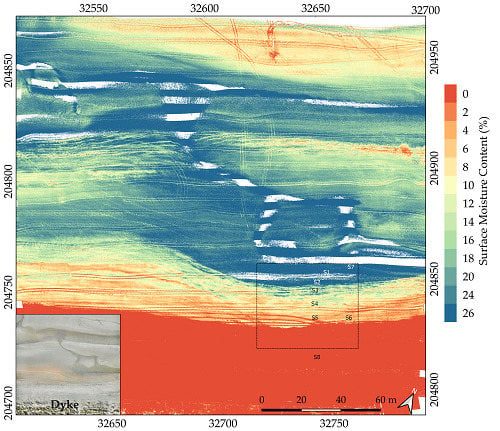Measuring Surface Moisture on a Sandy Beach based on Corrected Intensity Data of a Mobile Terrestrial LiDAR
Abstract
:1. Introduction
2. Theory
2.1. Surface Moisture-Reflectance Models
2.2. Correction of the Backscattered Intensity
3. Indoor Calibration Experiments
3.1. Terrestrial Laser Scanner
3.2. Incidence Angle Experiments
3.3. Distance Experiments
4. Results
4.1. Experimental Data Analysis
4.2. Moisture Estimation
5. Application of MTL
5.1. Study Site
5.2. MTL System and Beach Measurements
5.3. Beach Surface Moisture
5.4. Beach Surface Moisture Variation
6. Conclusions
- Both the scanning incidence angle and scanning distance have an influence on the backscattered intensity of the flat sand samples (the average sand grain diameter is 0.12 mm), in which the intensity values decrease gradually with incidence angles between 30 to 80°. When scanning orthogonally, the surface water film coating sand grains could contribute to a remarkable increase of the backscattered intensity (which is factor 7 above the intensity value of dry sand).
- The original intensity values decrease strongly from dry sand to a 3% moisture. This means that even a little moisture in sandy areas has a huge effect on the backscattered intensity of TLS.
- The proposed moisture model could effectively eliminate the effect of the scanning geometry on the backscattered intensity of TLS. The accuracy of the derived surface moisture amounts to a total standard error of a 2.0% moisture. Regarding the non-normal scanning, the method could accurately derive the full range of the sand moisture contents from 0% to 25% with a standard error of a 1.2% moisture. The result is considerably better than the previous TLS methods (using a Leica Scanstation 2 or a RIEGL VZ-400).
- Based on the proposed moisture model, the MTL system (using a Z&F/Leica HDS6100 laser scanner) is a promising technique to accurately and robustly measure the surface moisture on a sandy beach with an ultra-high spatial resolution (centimeter level) in a short time span (12 × 200 m per minute).
- On the other hand, some improvements should be considered in future studies. For example, the calibration experiments for varying distances could be conducted with a non-normal incidence angle. In addition, more sand samples could be collected from the target beach, in Groenendijk-Belgium, by a multi-person cooperation and the scanning efficiency of MTL could be increased by augmenting the laser scanner height or using a long-range LiDAR.
Author Contributions
Funding
Acknowledgments
Conflicts of Interest
References
- Edwards, B.L.; Schmutz, P.P.; Namikas, S.L. Comparison of surface moisture measurements with depth-integrated moisture measurements on a fine-grained beach. J. Coast. Res. 2013, 29, 1284–1291. [Google Scholar]
- Bauer, B.; Davidson-Arnott, R.; Hesp, P.; Namikas, S.; Ollerhead, J.; Walker, I. Aeolian sediment transport on a beach: Surface moisture, wind fetch, and mean transport. Geomorphology 2009, 105, 106–116. [Google Scholar] [CrossRef]
- Davidson-Arnott, R.G.; Yang, Y.; Ollerhead, J.; Hesp, P.A.; Walker, I.J. The effects of surface moisture on aeolian sediment transport threshold and mass flux on a beach. Earth Surf. Process. Landf. J. Br. Geomorphol. Res. Group 2008, 33, 55–74. [Google Scholar] [CrossRef]
- Oblinger, A.; Anthony, E.J. Surface moisture variations on a multibarred macrotidal beach: Implications for aeolian sand transport. J. Coast. Res. 2008, 24, 1194–1199. [Google Scholar] [CrossRef]
- Wiggs, G.; Baird, A.; Atherton, R. The dynamic effects of moisture on the entrainment and transport of sand by wind. Geomorphology 2004, 59, 13–30. [Google Scholar] [CrossRef]
- Nield, J.M.; Wiggs, G.F.; King, J.; Bryant, R.G.; Eckardt, F.D.; Thomas, D.S.; Washington, R. Climate–surface–pore-water interactions on a salt crusted playa: Implications for crust pattern and surface roughness development measured using terrestrial laser scanning. Earth Surf. Process. Landf. 2016, 41, 738–753. [Google Scholar] [CrossRef] [Green Version]
- Nield, J.M.; Wiggs, G.F.; Squirrell, R.S. Aeolian sand strip mobility and protodune development on a drying beach: Examining surface moisture and surface roughness patterns measured by terrestrial laser scanning. Earth Surf. Process. Landf. 2011, 36, 513–522. [Google Scholar] [CrossRef]
- Davidson-Arnott, R.G.; MacQuarrie, K.; Aagaard, T. The effect of wind gusts, moisture content and fetch length on sand transport on a beach. Geomorphology 2005, 68, 115–129. [Google Scholar] [CrossRef]
- McKenna Neuman, C.; Langston, G. Measurement of water content as a control of particle entrainment by wind. Earth Surf. Process. Landf. J. Br. Geomorphol. Res. Group 2006, 31, 303–317. [Google Scholar] [CrossRef]
- Namikas, S.; Edwards, B.; Bitton, M.; Booth, J.; Zhu, Y. Temporal and spatial variabilities in the surface moisture content of a fine-grained beach. Geomorphology 2010, 114, 303–310. [Google Scholar] [CrossRef]
- Atherton, R.J.; Baird, A.J.; Wiggs, G.F. Inter-tidal dynamics of surface moisture content on a meso-tidal beach. J. Coast. Res. 2001, 17, 482–489. [Google Scholar]
- Smit, Y.; Donker, J.J.; Ruessink, G. Spatiotemporal surface moisture variations on a barred beach and their relationship with groundwater fluctuations. Hydrology 2019, 6, 8. [Google Scholar] [CrossRef] [Green Version]
- Schmutz, P.P.; Namikas, S.L. Measurement and modeling of moisture content above an oscillating water table: Implications for beach surface moisture dynamics. Earth Surf. Process. Landf. 2013, 38, 1317–1325. [Google Scholar] [CrossRef]
- Nolet, C.; Poortinga, A.; Roosjen, P.; Bartholomeus, H.; Ruessink, G. Measuring and modeling the effect of surface moisture on the spectral reflectance of coastal beach sand. PLoS ONE 2014, 9, e112151. [Google Scholar] [CrossRef] [PubMed]
- Darke, I.; Davidson-Arnott, R.; Ollerhead, J. Measurement of beach surface moisture using surface brightness. J. Coast. Res. 2009, 25, 248–256. [Google Scholar] [CrossRef]
- Yang, Y.; Davidson-Arnott, R.G. Rapid measurement of surface moisture content on a beach. J. Coast. Res. 2005, 21, 447–452. [Google Scholar] [CrossRef]
- Tsegaye, T.D.; Tadesse, W.; Coleman, T.L.; Jackson, T.J.; Tewolde, H. Calibration and modification of impedance probe for near surface soil moisture measurements. Can. J. Soil Sci. 2004, 84, 237–243. [Google Scholar] [CrossRef] [Green Version]
- Edwards, B.L.; Namikas, S.L. Small-scale variability in surface moisture on a fine-grained beach: Implications for modeling aeolian transport. Earth Surf. Process. Landf. 2009, 34, 1333–1338. [Google Scholar] [CrossRef]
- Schmutz, P.P.; Namikas, S.L. Utility of the Delta-T Theta Probe for obtaining surface moisture measurements from beaches. J. Coast. Res. 2011, 27, 478–484. [Google Scholar]
- Sherman, D.J.; Jackson, D.W.; Namikas, S.L.; Wang, J. Wind-blown sand on beaches: An evaluation of models. Geomorphology 1998, 22, 113–133. [Google Scholar] [CrossRef]
- Williams, R.; Brasington, J.; Vericat, D.; Hicks, D. Hyperscale terrain modelling of braided rivers: Fusing mobile terrestrial laser scanning and optical bathymetric mapping. Earth Surf. Process. Landf. 2014, 39, 167–183. [Google Scholar] [CrossRef]
- Ångström, A. The albedo of various surfaces of ground. Geogr. Ann. 1925, 7, 323–342. [Google Scholar]
- Lobell, D.B.; Asner, G.P. Moisture effects on soil reflectance. Soil Sci. Soc. Am. J. 2002, 66, 722–727. [Google Scholar] [CrossRef]
- Twomey, S.A.; Bohren, C.F.; Mergenthaler, J.L. Reflectance and albedo differences between wet and dry surfaces. Appl. Opt. 1986, 25, 431–437. [Google Scholar] [CrossRef] [PubMed]
- Philpot, W. Spectral reflectance of wetted soils. Proc. ASD IEEE GRS 2010, 2. [Google Scholar] [CrossRef]
- Darke, I.; Neuman, C.M. Field study of beach water content as a guide to wind erosion potential. J. Coast. Res. 2008, 24, 1200–1208. [Google Scholar] [CrossRef]
- Delgado-Fernandez, I.; Davidson-Arnott, R.; Ollerhead, J. Application of a remote sensing technique to the study of coastal dunes. J. Coast. Res. 2009, 25, 1160–1167. [Google Scholar] [CrossRef]
- Delgado-Fernandez, I. Meso-scale modelling of aeolian sediment input to coastal dunes. Geomorphology 2011, 130, 230–243. [Google Scholar] [CrossRef] [Green Version]
- Delgado-Fernandez, I.R. Davidson-Arnott. Meso-scale aeolian sediment input to coastal dunes: The nature of aeolian transport events. Geomorphology 2011, 126, 217–232. [Google Scholar] [CrossRef] [Green Version]
- Edwards, B.L.; Namikas, S.L.; D’sa, E.J. Simple infrared techniques for measuring beach surface moisture. Earth Surf. Process. Landf. 2013, 38, 192–197. [Google Scholar] [CrossRef]
- Nield, J.M.; Wiggs, G.F. The application of terrestrial laser scanning to aeolian saltation cloud measurement and its response to changing surface moisture. Earth Surf. Process. Landf. 2011, 36, 273–278. [Google Scholar] [CrossRef]
- Nield, J.M.; King, J.; Jacobs, B. Detecting surface moisture in aeolian environments using terrestrial laser scanning. Aeolian Res. 2014, 12, 9–17. [Google Scholar] [CrossRef]
- Smit, Y.; Ruessink, G.; Brakenhoff, L.B.; Donker, J.J. Measuring spatial and temporal variation in surface moisture on a coastal beach with a near-infrared terrestrial laser scanner. Aeolian Res. 2018, 31, 19–27. [Google Scholar] [CrossRef]
- Ruessink, G.; Brakenhoff, L.; van Maarseveen, M. Measurement of surface moisture using infra-red terrestrial laser scanning. In Proceedings of the EGU General Assembly 2014, Vienna, Austria, 27 April–2 May 2014; Volume 16. EGU2014–2797. [Google Scholar]
- Kukko, A.; Kaasalainen, S.; Litkey, P. Effect of incidence angle on laser scanner intensity and surface data. Appl. Opt. 2008, 47, 986–992. [Google Scholar] [CrossRef]
- Franceschi, M.; Teza, G.; Preto, N.; Pesci, A.; Galgaro, A.; Girardi, S. Discrimination between marls and limestones using intensity data from terrestrial laser scanner. ISPRS J. Photogramm. Remote Sens. 2009, 64, 522–528. [Google Scholar] [CrossRef]
- Kaasalainen, S.; Kukko, A.; Lindroos, T.; Litkey, P.; Kaartinen, H.; Hyyppa, J.; Ahokas, E. Brightness measurements and calibration with airborne and terrestrial laser scanners. IEEE Trans. Geosci. Remote Sens. 2008, 46, 528–534. [Google Scholar] [CrossRef]
- González-Jorge, H.; Gonzalez-Aguilera, D.; Rodriguez-Gonzalvez, P.; Arias, P. Monitoring biological crusts in civil engineering structures using intensity data from terrestrial laser scanners. Constr. Build. Mater. 2012, 31, 119–128. [Google Scholar] [CrossRef]
- Kaasalainen, S.; Jaakkola, A.; Kaasalainen, M.; Krooks, A.; Kukko, A. Analysis of incidence angle and distance effects on terrestrial laser scanner intensity: Search for correction methods. Remote Sens. 2011, 3, 2207–2221. [Google Scholar] [CrossRef] [Green Version]
- Kaasalainen, S.; Niittymaki, H.; Krooks, A.; Koch, K.; Kaartinen, H.; Vain, A.; Hyyppa, H. Effect of target moisture on laser scanner intensity. IEEE Trans. Geosci. Remote Sens. 2010, 48, 2128–2136. [Google Scholar] [CrossRef]
- Bohren, C.F.; Huffman, D.R. Absorption and Scattering of Light by Small Particles; John Wiley & Sons: New York, USA, 2008; pp. 3–9. [Google Scholar]
- Duke, C.; Guérif, M. Crop reflectance estimate errors from the SAIL model due to spatial and temporal variability of canopy and soil characteristics. Remote Sens. Environ. 1998, 66, 286–297. [Google Scholar] [CrossRef]
- Shin, H.; Yu, J.; Jeong, Y.; Wang, L.; Yang, D.-Y. Case-Based Regression Models Defining the Relationships Between Moisture Content and Shortwave Infrared Reflectance of Beach Sands. IEEE J. Sel. Top. Appl. Earth Obs. Remote Sens. 2017, 10, 4512–4521. [Google Scholar] [CrossRef]
- Wagner, W.; Ullrich, A.; Ducic, V.; Melzer, T.; Studnicka, N. Gaussian decomposition and calibration of a novel small-footprint full-waveform digitising airborne laser scanner. ISPRS J. Photogramm. Remote Sens. 2006, 60, 100–112. [Google Scholar] [CrossRef]
- Höfle, B.; Pfeifer, N. Correction of laser scanning intensity data: Data and model-driven approaches. ISPRS J. Photogramm. Remote Sens. 2007, 62, 415–433. [Google Scholar] [CrossRef]
- Fang, W.; Huang, X.; Zhang, F.; Li, D. Intensity correction of terrestrial laser scanning data by estimating laser transmission function. IEEE Trans. Geosci. Remote Sens. 2015, 53, 942–951. [Google Scholar] [CrossRef]
- Tan, K.; Cheng, X. Intensity data correction based on incidence angle and distance for terrestrial laser scanner. J. Appl. Remote Sens. 2015, 9, 094094. [Google Scholar] [CrossRef]
- Tan, K.; Cheng, X.; Ding, X.; Zhang, Q. Intensity data correction for the distance effect in terrestrial laser scanners. IEEE J. Sel. Top. Appl. Earth Obs. Remote Sens. 2016, 9, 304–312. [Google Scholar] [CrossRef]
- Coren, F.; Sterzai, P. Radiometric correction in laser scanning. Int. J. Remote Sens. 2006, 27, 3097–3104. [Google Scholar] [CrossRef]
- Errington, A.F.; Daku, B.L.; Prugger, A.F. A model based approach to intensity normalization for terrestrial laser scanners. In Proceedings of the International Symposium on Lidar and Radar Mapping 2011: Technologies and Applications, Nanjing, China, 26–29 May 2011; p. 828605. [Google Scholar]
- Jutzi, B.; Gross, H. Normalization of LiDAR intensity data based on range and surface incidence angle. Int. Arch. Photogramm. Remote Sens. Spat. Inf. Sci. 2009, 38, 213–218. [Google Scholar]
- Teo, T.-A.; Yu, H.-L. Empirical radiometric normalization of road points from terrestrial mobile LiDAR system. Remote Sens. 2015, 7, 6336–6357. [Google Scholar] [CrossRef] [Green Version]
- Kaasalainen, S.; Hyyppa, H.; Kukko, A.; Litkey, P.; Ahokas, E.; Hyyppa, J.; Lehner, H.; Jaakkola, A.; Suomalainen, J.; Akujarvi, A. Radiometric calibration of LIDAR intensity with commercially available reference targets. IEEE Trans. Geosci. Remote Sens. 2009, 47, 588–598. [Google Scholar] [CrossRef]
- Ahokas, E.; Kaasalainen, S.; Hyyppä, J.; Suomalainen, J. Calibration of the Optech ALTM 3100 laser scanner intensity data using brightness targets. Int. Arch. Photogramm. Remote Sens. Spat. Inf. Sci. 2006, 36, 1Á6. [Google Scholar]
- Bitenc, M. Evaluation of a laser Land-Based Mobile Mapping System for Measuring Sandy Coast Morphology. Master Thesis, Delft University of Technology, Delft, The Netherlands, 8 March 2010. [Google Scholar]
- Ding, Q.; Chen, W.; King, B.; Liu, Y.; Liu, G. Combination of overlap-driven adjustment and Phong model for LiDAR intensity correction. ISPRS J. Photogramm. Remote Sens. 2013, 75, 40–47. [Google Scholar] [CrossRef]
- Tan, K.; Cheng, X. Specular reflection effects elimination in terrestrial laser scanning intensity data using Phong model. Remote Sens. 2017, 9, 853. [Google Scholar] [CrossRef] [Green Version]
- Xu, T.; Xu, L.; Yang, B.; Li, X.; Yao, J. Terrestrial laser scanning intensity correction by piecewise fitting and overlap-driven adjustment. Remote Sens. 2017, 9, 1090. [Google Scholar] [CrossRef] [Green Version]
- Tan, K.; Cheng, X. Correction of incidence angle and distance effects on TLS intensity data based on reference targets. Remote Sens. 2016, 8, 251. [Google Scholar] [CrossRef] [Green Version]
- Tan, K.; Chen, J.; Qian, W.; Zhang, W.; Shen, F.; Cheng, X. Intensity Data Correction for Long-Range Terrestrial Laser Scanners: A Case Study of Target Differentiation in an Intertidal Zone. Remote Sens. 2019, 11, 331. [Google Scholar] [CrossRef] [Green Version]
- Kaasalainen, S.; Krooks, A.; Kukko, A.; Kaartinen, H. Radiometric calibration of terrestrial laser scanners with external reference targets. Remote Sens. 2009, 1, 144–158. [Google Scholar] [CrossRef] [Green Version]
- Tan, K.; Zhang, W.; Shen, F.; Cheng, X. Investigation of tls intensity data and distance measurement errors from target specular reflections. Remote Sens. 2018, 10, 1077. [Google Scholar] [CrossRef] [Green Version]
- Hofle, B. Radiometric correction of terrestrial LiDAR point cloud data for individual maize plant detection. IEEE Geosci. Remote Sens. Lett. 2014, 11, 94–98. [Google Scholar] [CrossRef]
- Pesci, A.; Teza, G. Effects of surface irregularities on intensity data from laser scanning: An experimental approach. Ann. Geophys. 2008, 51, 839–848. [Google Scholar]
- Kaasalainen, S.; Vain, A.; Krooks, A.; Kukko, A. Topographic and distance effects in laser scanner intensity correction. Int. Arch. Photogramm. Remote Sens. Spat. Inf. Sci. 2009, 38, 219–222. [Google Scholar]
- Deronde, B.; Houthuys, R.; Henriet, J.P.; Lancker, V.V. Monitoring of the sediment dynamics along a sandy shoreline by means of airborne hyperspectral remote sensing and LIDAR: A case study in Belgium. Earth Surf. Process. Landf. J. Br. Geomorphol. Res. Group. 2008, 33, 280–294. [Google Scholar] [CrossRef]
- Stal, C.; Incoul, A.; de Maeyer, P.; Deruyter, G.; Nuttens, T.; de Wulf, A. Mobile Mapping and the Use of Backscatter Data for the Modelling of Intertidal Zones of Beaches. In Proceedings of the 14th SGEM GeoConference on Informatics, Geoinformatics and Remote Sensing, Sofia, Bulgaria, 19–25 June 2014. [Google Scholar]
- Qinsy Support Desk. Available online: https://confluence.qps.nl/qinsy/latest/en/how-to-calibrate-a-multibeam-echosounder-35587229.html (accessed on 15 August 2019).

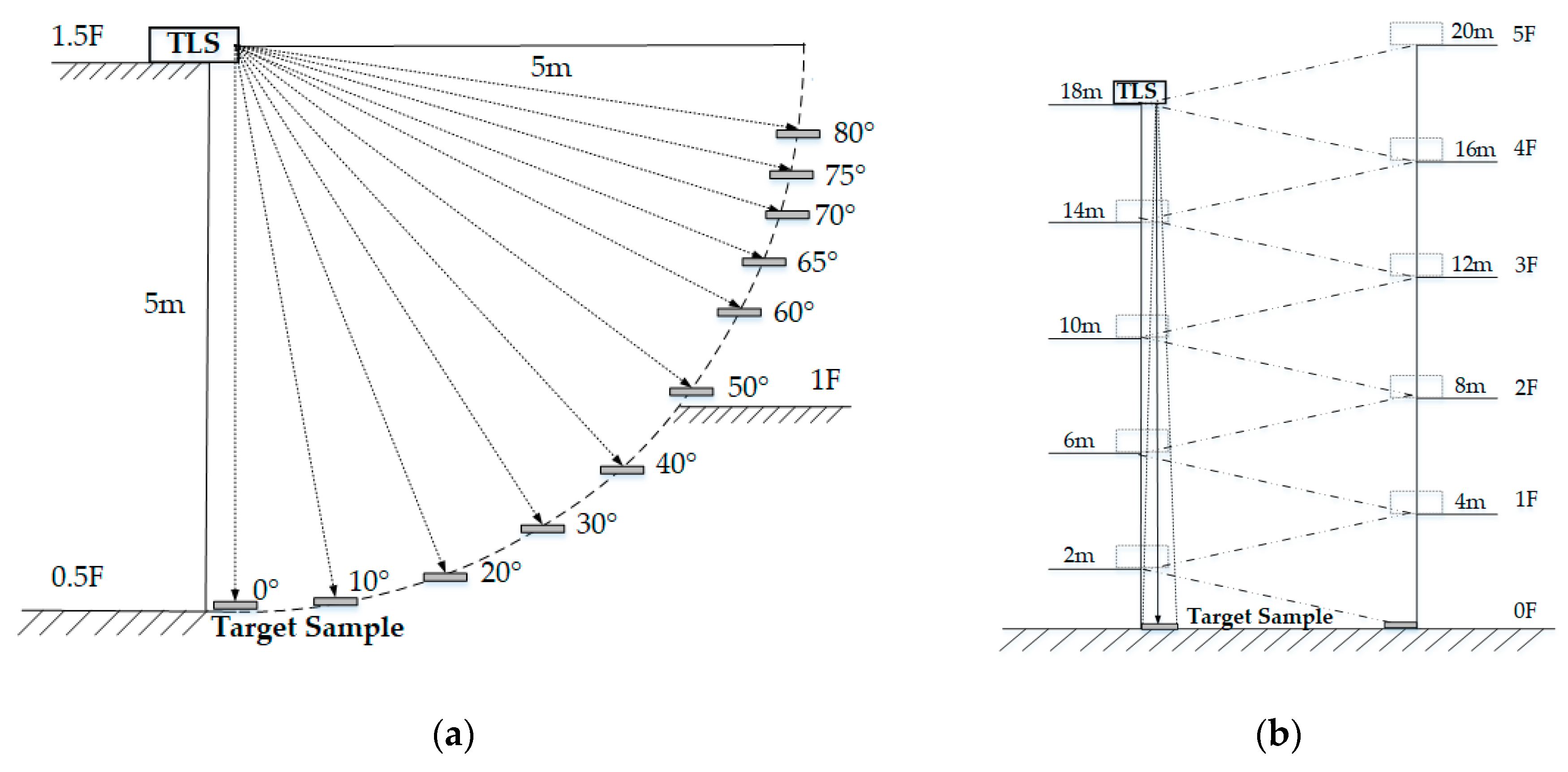
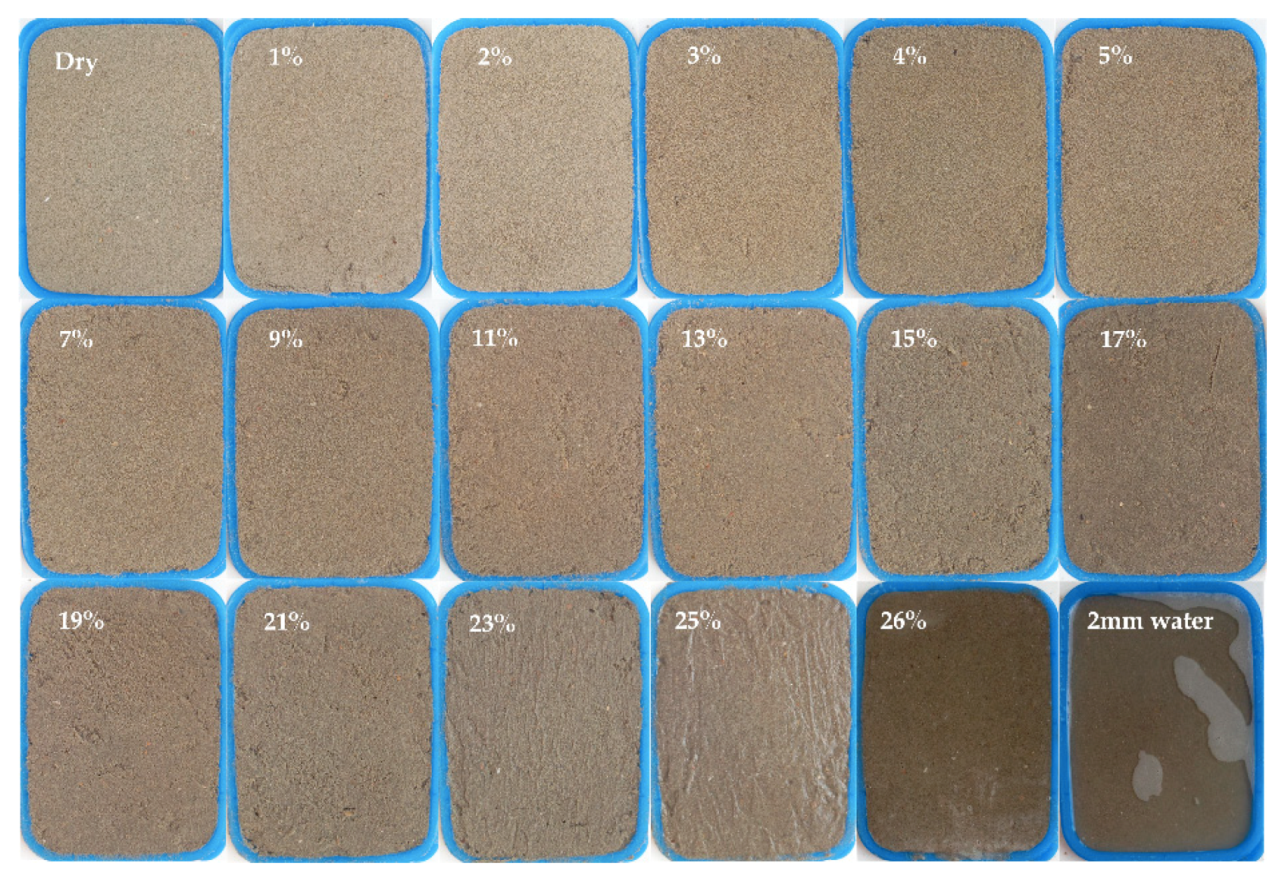
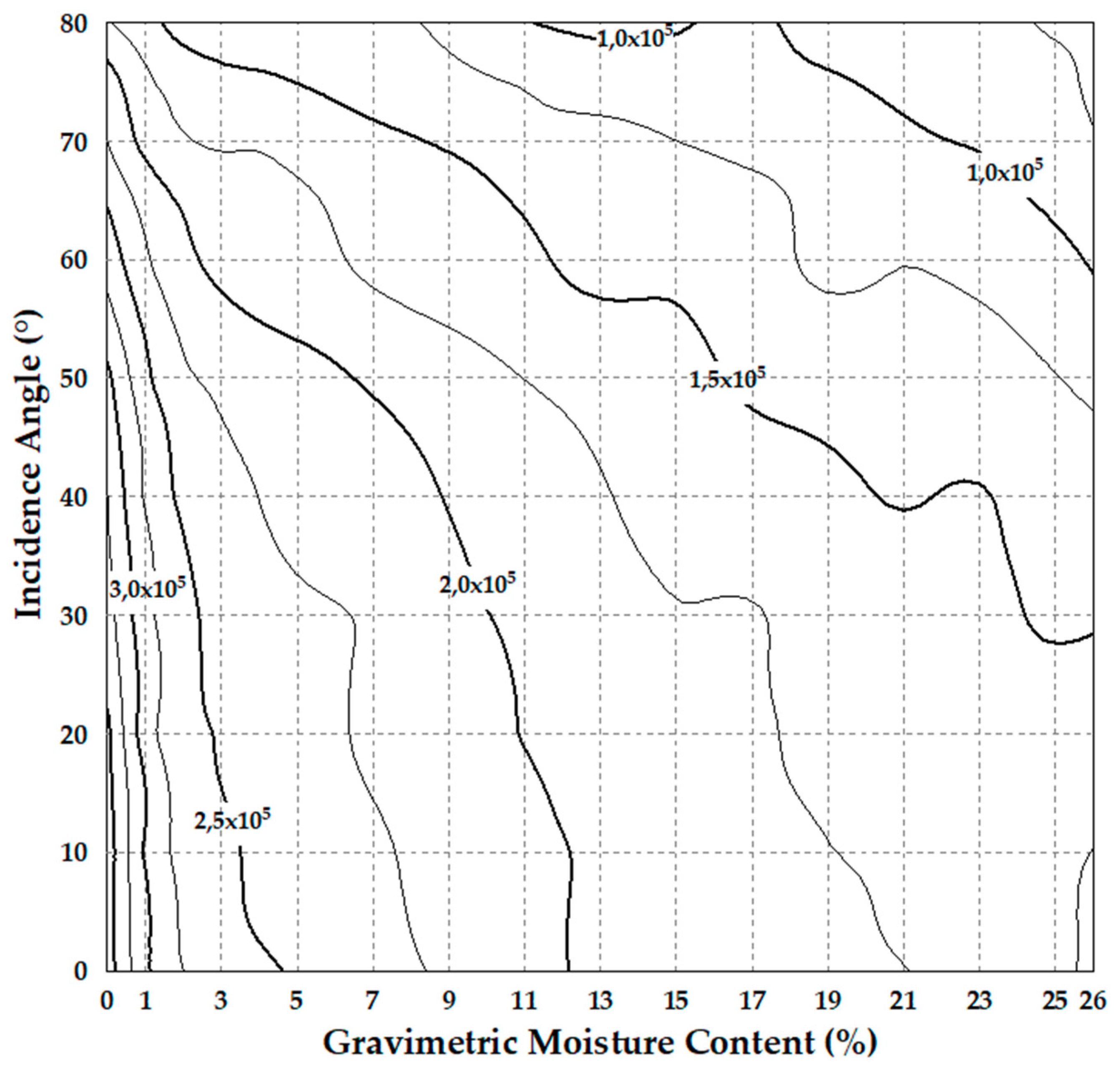
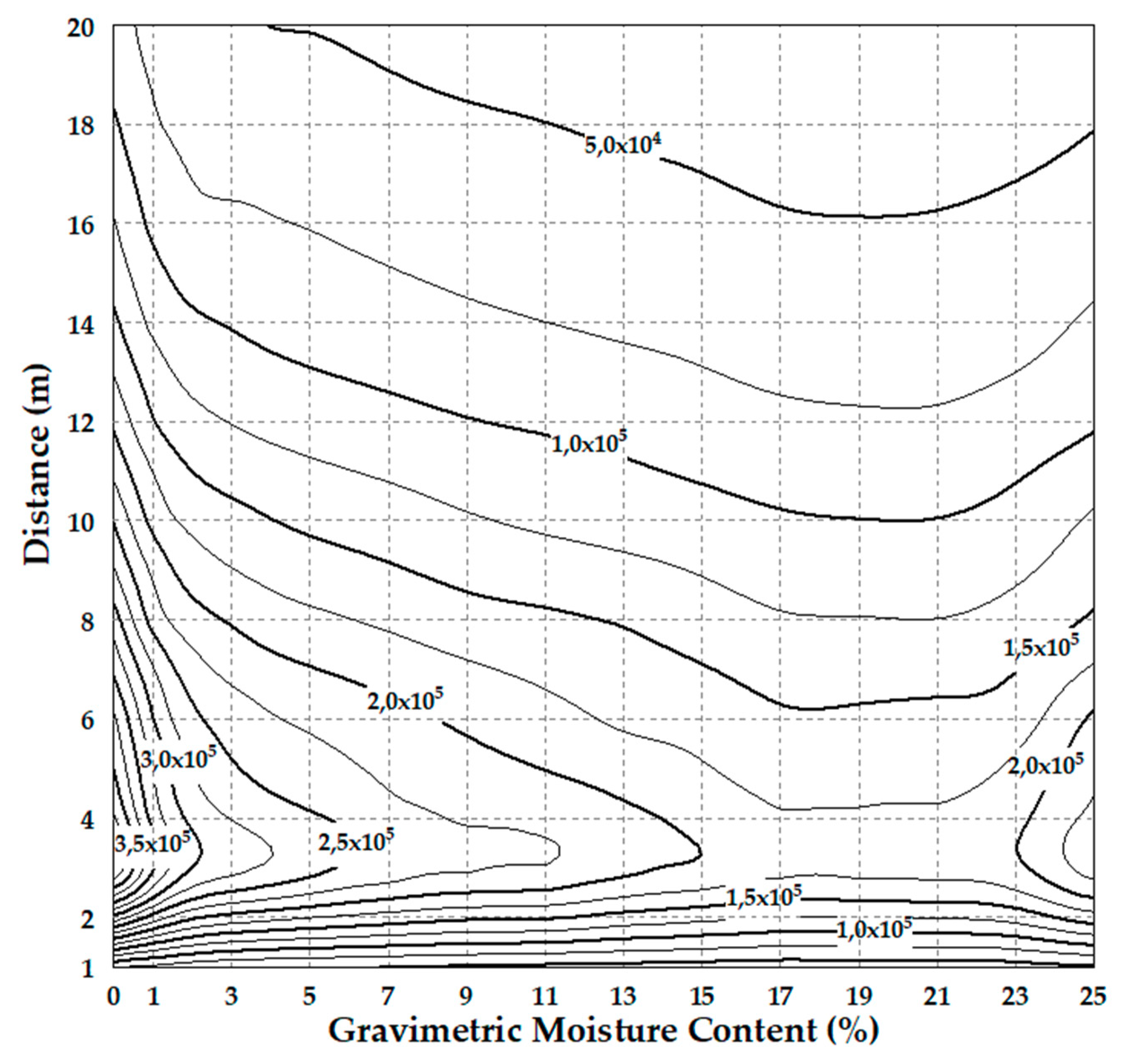
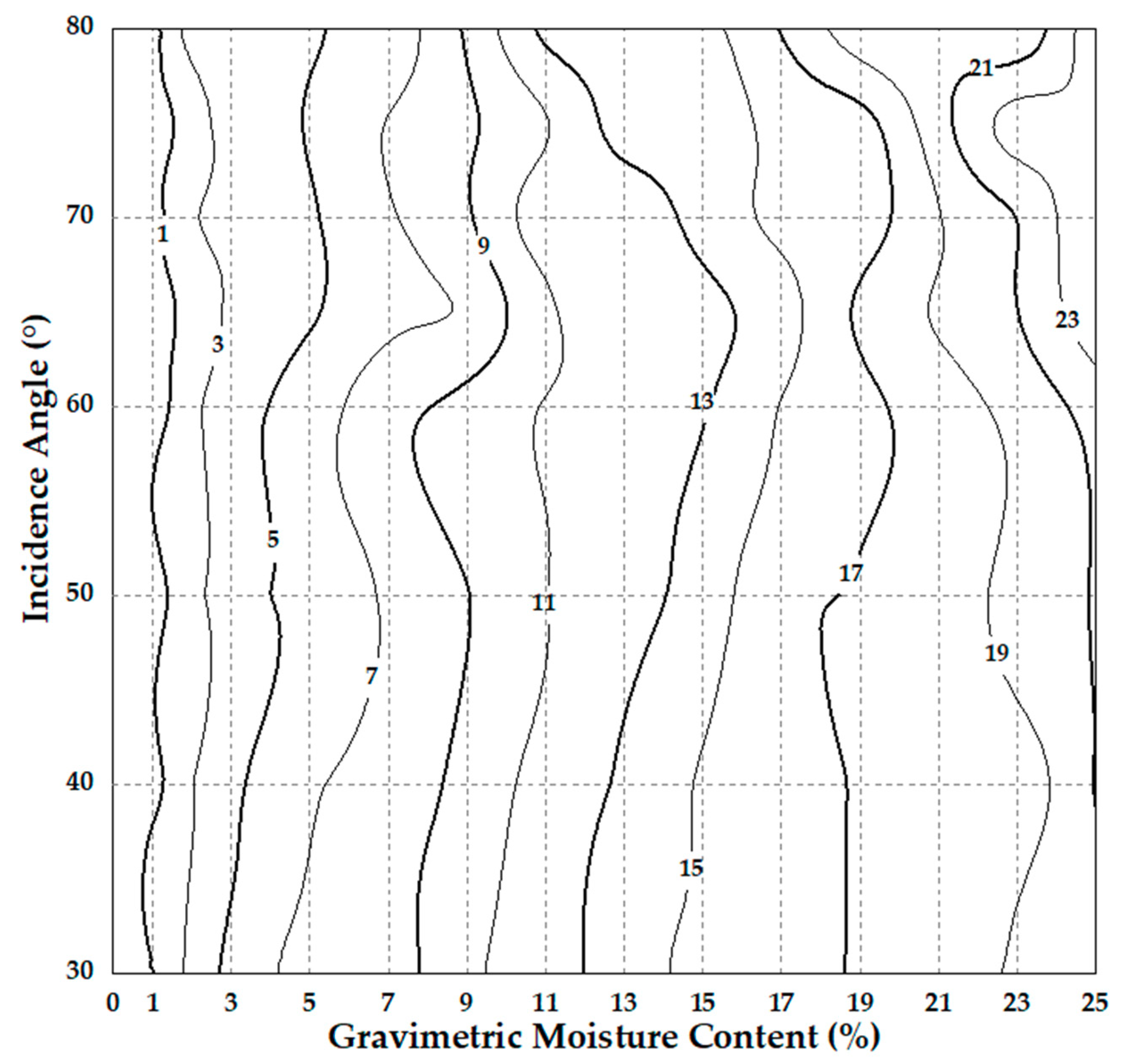
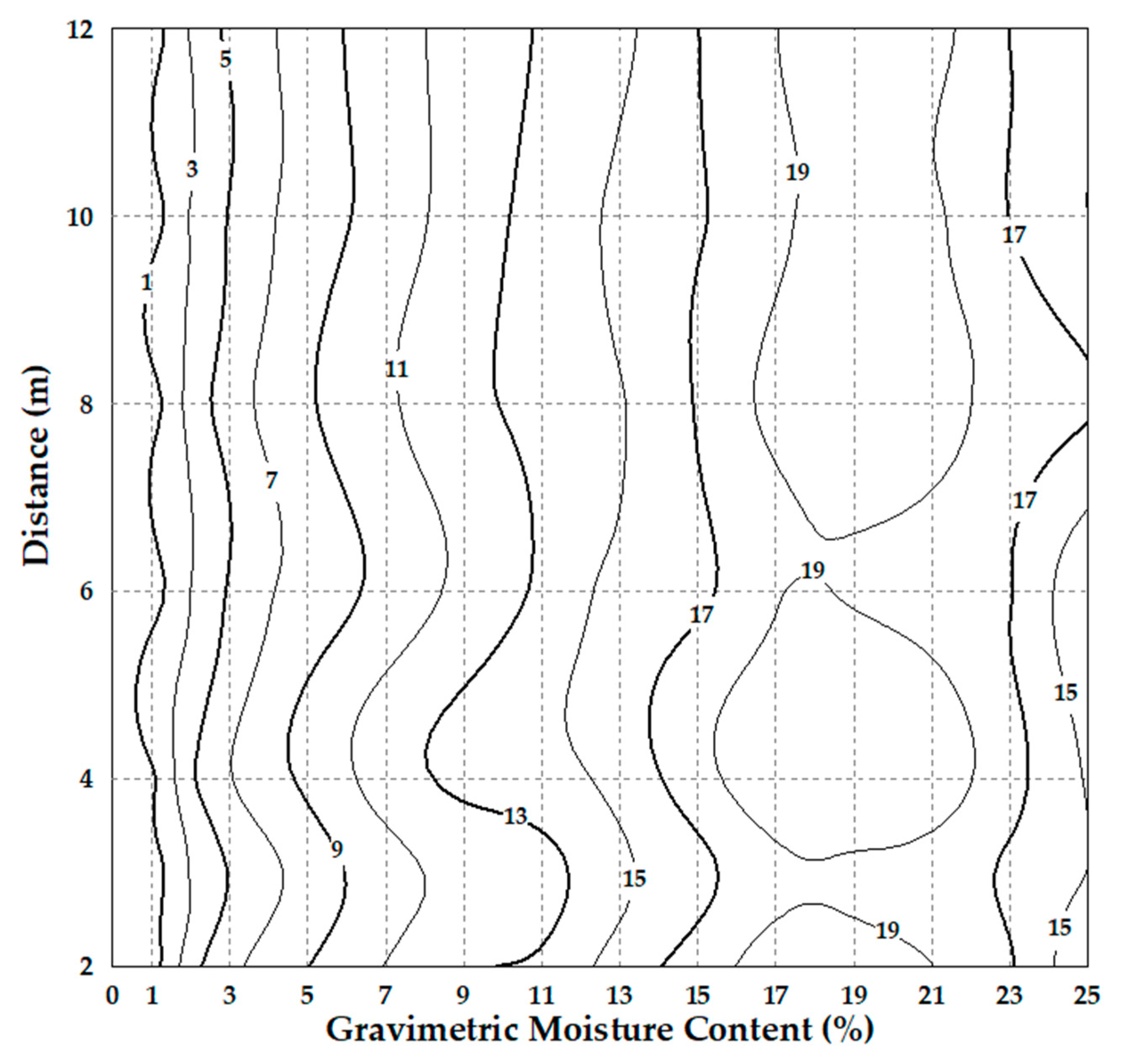
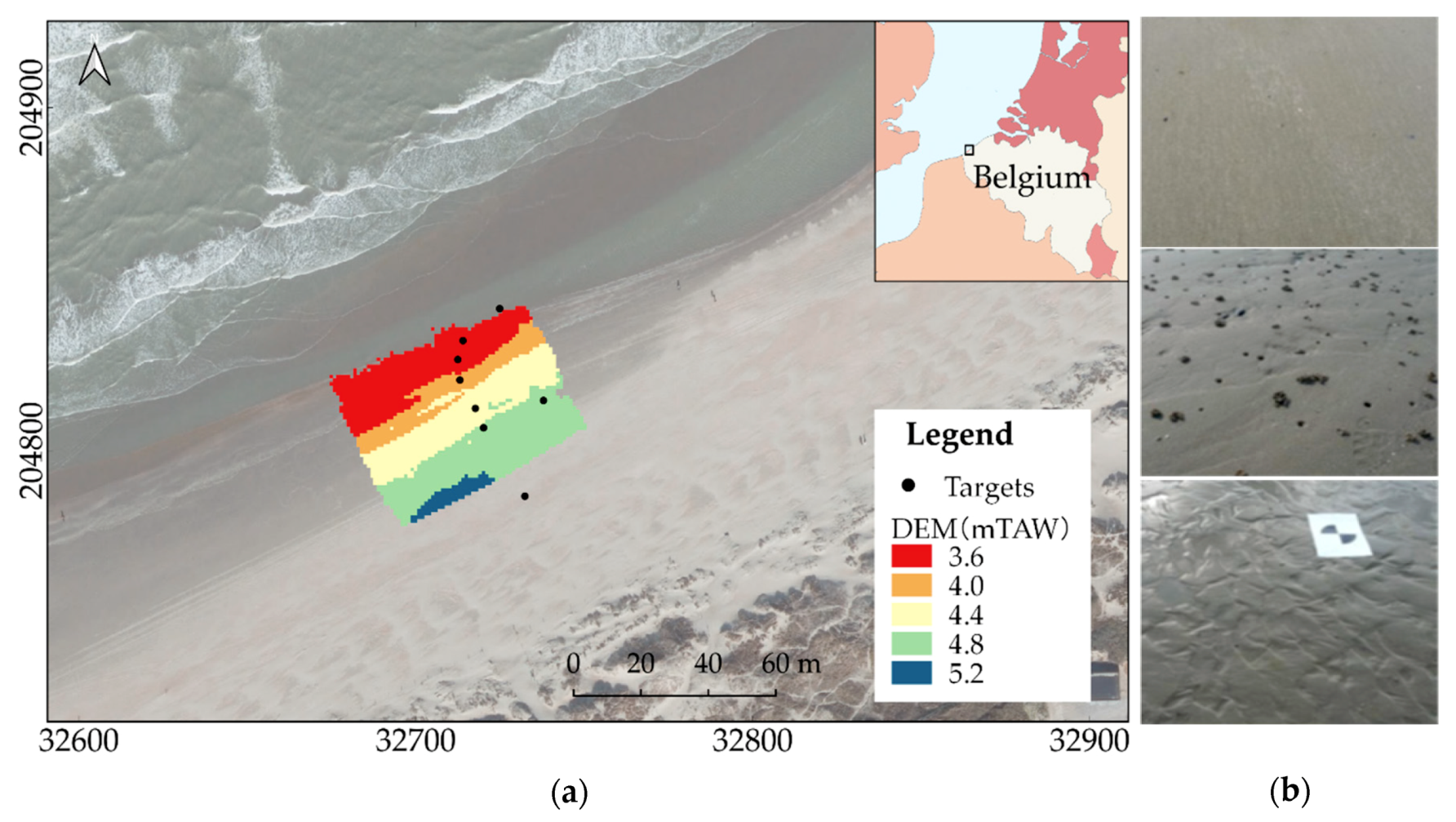
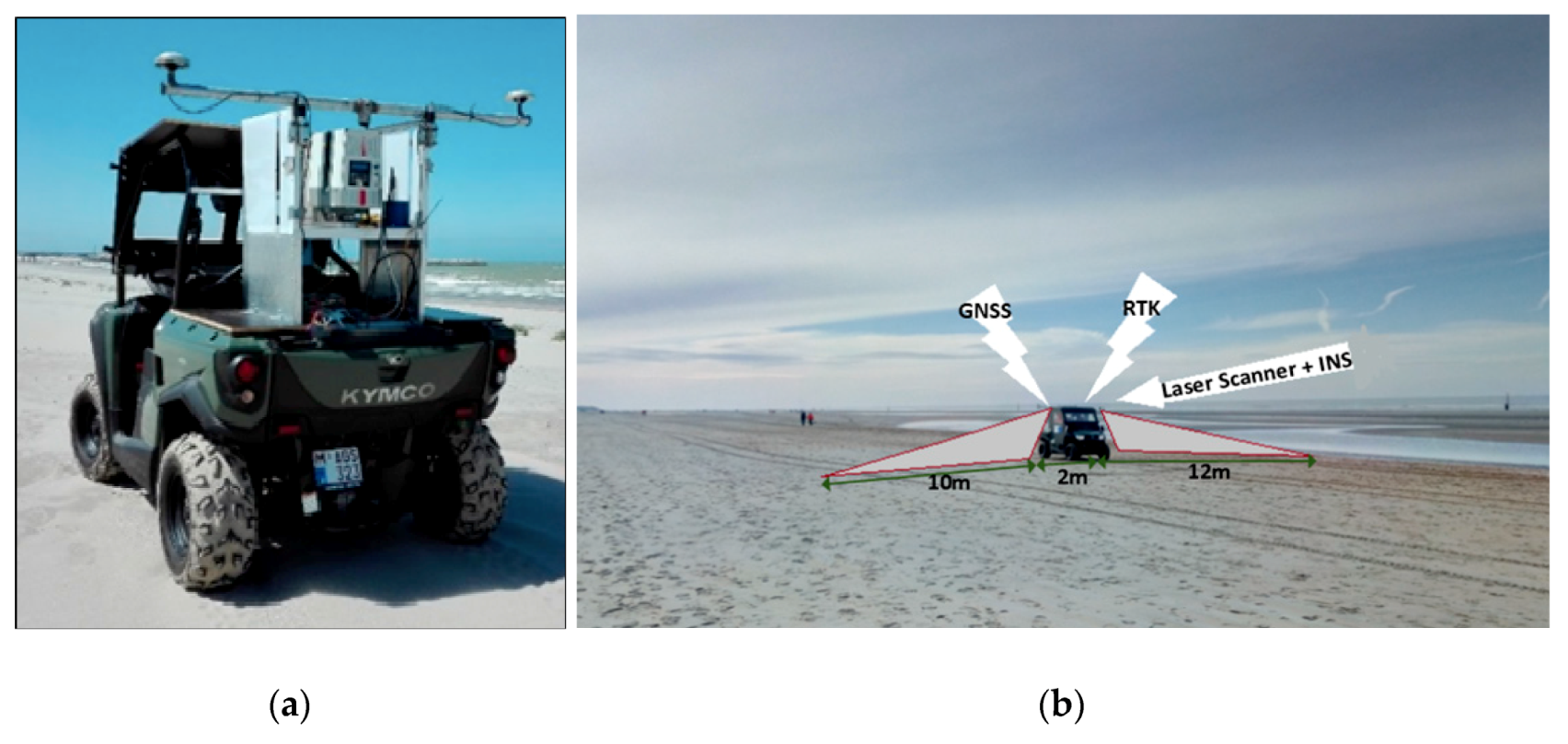
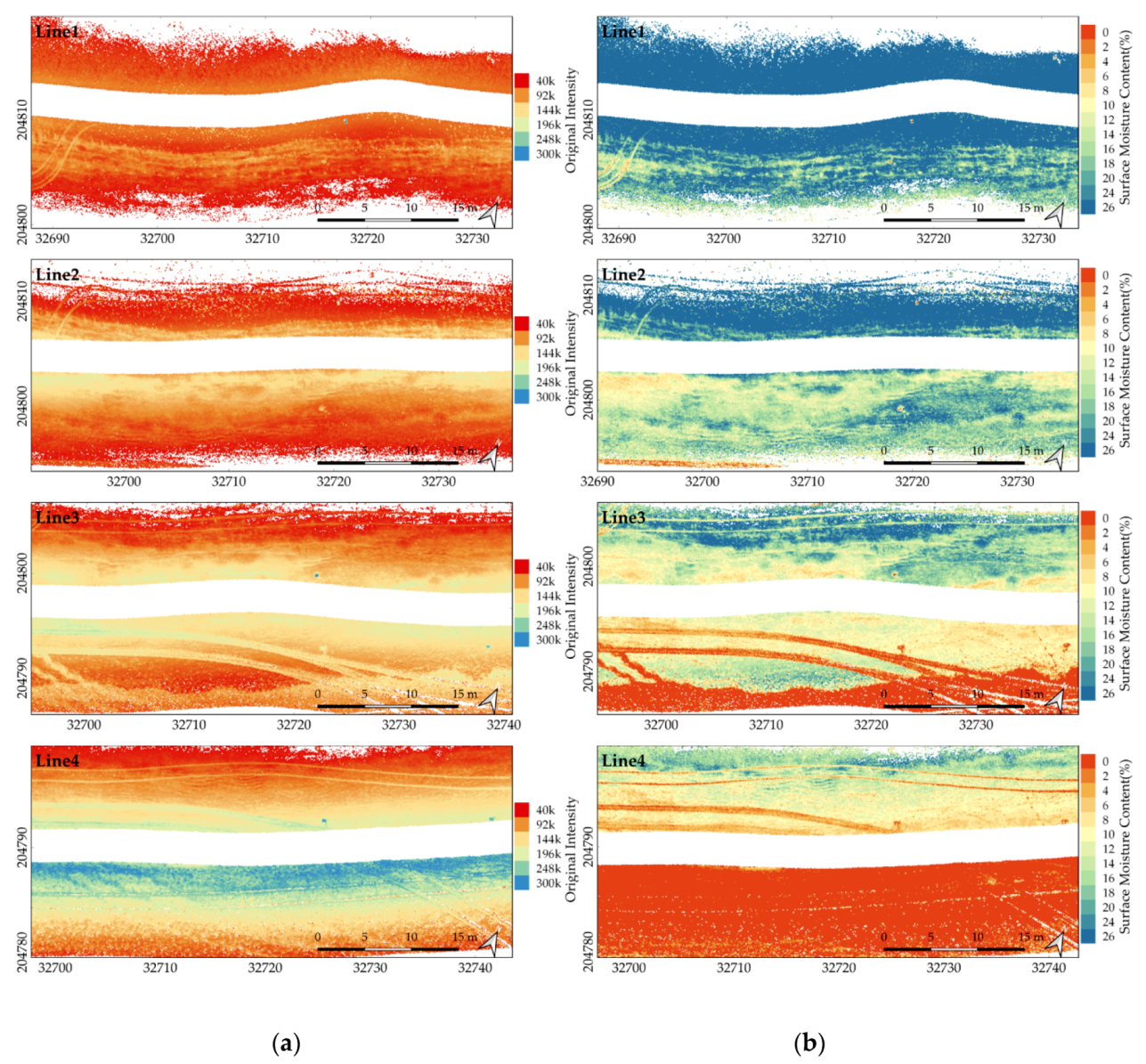


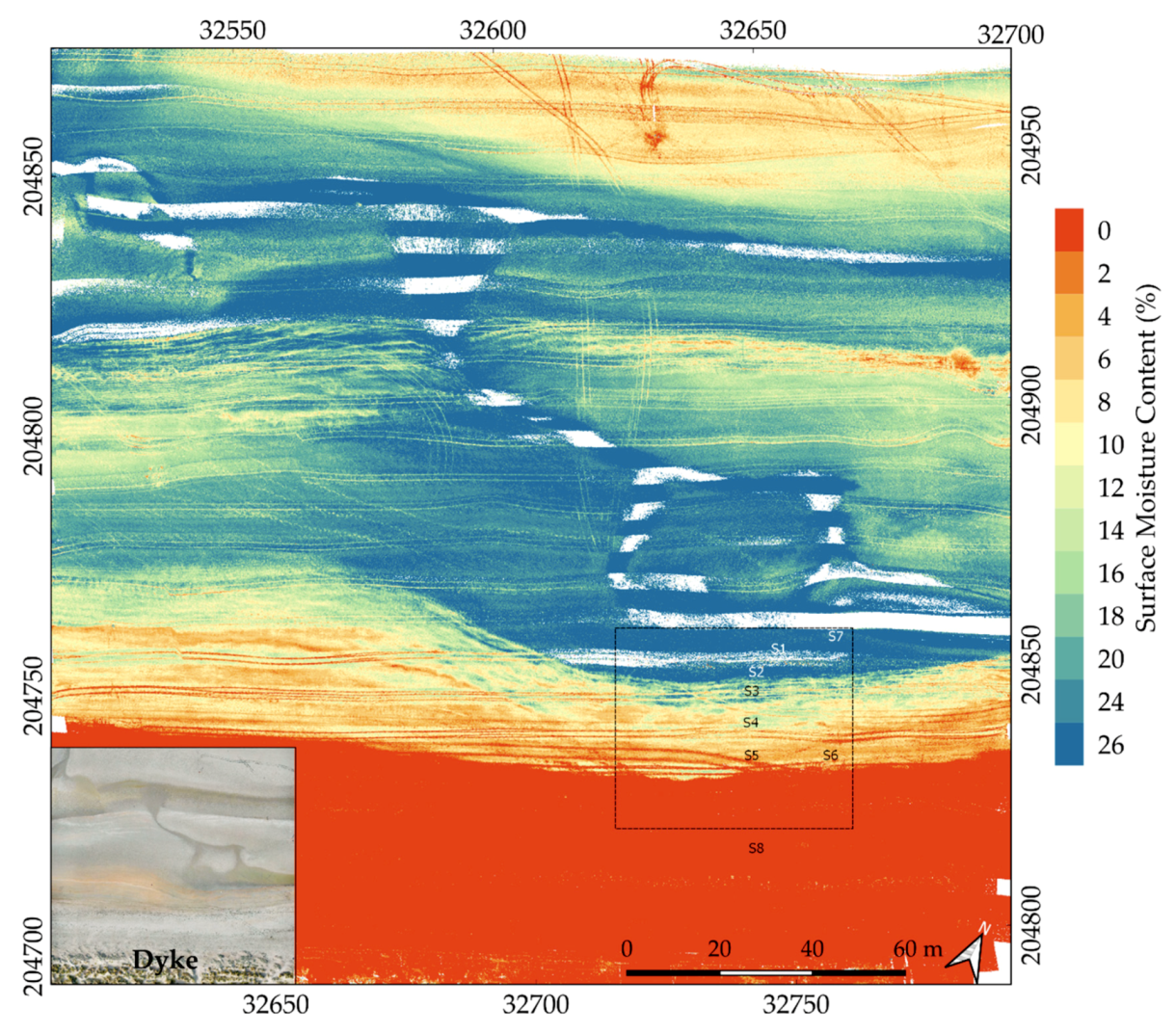
| Attribute | Value |
|---|---|
| Wavelength | 650–690 nm |
| Maximum range | 50 m at 18% albedo |
| Field of View | 360° × 310° |
| Laser beam divergence | 0.22 mrad |
| Position accuracy | 5 mm (1–25 m), 9 mm (25–50 m) |
| −3.230.28 | |||||||
| 1 | 0.750.13 | 1 | |||||
| 5 | −10,398.951509.62 | 13,064.052391.26 | −3990.40540.70 | 564.6247.56 | −38.291.48 | 1 | |
| Moisture (%) | Incidence Angle | Mean | Std.Dev. | Std.Error | |||||||
|---|---|---|---|---|---|---|---|---|---|---|---|
| 30° | 40° | 50° | 60° | 65° | 70° | 75° | 80° | ||||
| 0 | 0 | 0 | 0 | 0 | 0 | 0 | 0 | 0 | 0 | 0 | 0 |
| 1 | 0.8 | 0.2 | 0 | 0 | 0 | 0.3 | 0 | 0.1 | 0.2 | 0.3 | 0.8 |
| 2 | 3.7 | 3.1 | 2.7 | 2.6 | 1.8 | 2.8 | 2.0 | 4.3 | 2.9 | 0.8 | 0.9 |
| 3 | 5.5 | 4.5 | 3.6 | 4.2 | 3.3 | 3.8 | 3.9 | 4.7 | 4.2 | 0.7 | 1.2 |
| 4 | 6.9 | 5.8 | 5.1 | 5.0 | 4.1 | 3.4 | 4.0 | 4.4 | 4.9 | 1.1 | 1.0 |
| 5 | 7.4 | 6.8 | 5.3 | 5.9 | 4.7 | 4.7 | 5.3 | 4.9 | 5.6 | 1.0 | 0.8 |
| 7 | 8.1 | 7.7 | 7.3 | 8.4 | 6.6 | 6.8 | 7.1 | 5.8 | 7.2 | 0.8 | 0.7 |
| 9 | 10.6 | 9.7 | 8.9 | 9.6 | 7.2 | 8.7 | 8.7 | 9.3 | 9.1 | 1.0 | 0.7 |
| 11 | 12.1 | 11.8 | 11.0 | 11.1 | 10.7 | 12.2 | 10.8 | 13.5 | 11.6 | 1.0 | 0.8 |
| 13 | 14.0 | 13.3 | 12.2 | 11.3 | 12.1 | 11.9 | 13.7 | 13.9 | 12.8 | 1.0 | 0.9 |
| 15 | 15.4 | 15.2 | 13.9 | 12.8 | 12.4 | 13.7 | 13.9 | 14.4 | 14.0 | 1.1 | 1.2 |
| 17 | 15.3 | 16.2 | 16.6 | 15.1 | 14.1 | 15.6 | 15.6 | 17.1 | 15.7 | 0.9 | 1.3 |
| 19 | 17.4 | 17.2 | 17.1 | 16.4 | 17.4 | 15.9 | 16.2 | 20.2 | 17.2 | 1.3 | 2.1 |
| 21 | 18.6 | 18.7 | 18.4 | 18.0 | 19.2 | 18.9 | 20.3 | 20.6 | 19.1 | 0.9 | 1.9 |
| 23 | 19.2 | 17.9 | 19.4 | 19.6 | 20.9 | 20.9 | 24.0 | 19.4 | 20.2 | 1.8 | 3.1 |
| 25 | 20.8 | 21.2 | 21.2 | 21.9 | 24.5 | 25.0 | 23.2 | 24.4 | 22.8 | 1.7 | 2.2 |
| Total Std. Error: | 1.2 | ||||||||||
| Moisture (%) | Distance | Mean | Std.Dev. | Std.Error | ||||||
|---|---|---|---|---|---|---|---|---|---|---|
| 2m | 3m | 4m | 6m | 8m | 10m | 12m | ||||
| 0 | 0 | 0 | 0 | 0 | 0 | 0 | 0 | 0 | 0 | 0 |
| 1 | 0 | 0 | 0.4 | 0 | 0 | 0 | 0 | 0.1 | 0.2 | 0.9 |
| 2 | 4.4 | 3.3 | 4.9 | 3.2 | 4.0 | 3.3 | 3.4 | 3.8 | 0.7 | 1.8 |
| 3 | 6.5 | 5.0 | 6.9 | 5.2 | 5.9 | 5.1 | 5.5 | 5.7 | 0.7 | 2.7 |
| 4 | 7.8 | 6.5 | 8.3 | 6.9 | 7.6 | 6.8 | 6.7 | 7.2 | 0.7 | 3.2 |
| 5 | 9.0 | 7.8 | 9.4 | 7.6 | 8.8 | 7.9 | 8.0 | 8.4 | 0.7 | 3.4 |
| 7 | 11.1 | 10.1 | 12.0 | 9.6 | 10.7 | 9.8 | 10.0 | 10.5 | 0.9 | 3.5 |
| 9 | 12.9 | 11.5 | 13.5 | 11.5 | 12.5 | 12.0 | 11.9 | 12.3 | 0.8 | 3.3 |
| 11 | 13.3 | 12.2 | 14.2 | 13.3 | 13.5 | 13.7 | 13.1 | 13.3 | 0.6 | 2.3 |
| 13 | 16.0 | 14.6 | 15.7 | 15.7 | 14.8 | 15.4 | 14.5 | 15.3 | 0.6 | 2.3 |
| 15 | 17.9 | 16.3 | 18.3 | 16.4 | 17.2 | 16.7 | 17.0 | 17.1 | 0.7 | 2.1 |
| 17 | 20.0 | 18.6 | 20.4 | 18.9 | 19.6 | 18.7 | 19.0 | 19.3 | 0.7 | 2.3 |
| 19 | 19.6 | 18.7 | 20.3 | 18.8 | 20.0 | 19.4 | 19.9 | 19.5 | 0.6 | 0.7 |
| 21 | 19.0 | 18.3 | 20.2 | 18.2 | 20.1 | 19.3 | 19.8 | 19.3 | 0.8 | 1.7 |
| 23 | 17.3 | 16.6 | 17.7 | 17.2 | 17.9 | 16.9 | 16.9 | 17.2 | 0.5 | 5.8 |
| 25 | 13.2 | 15.0 | 14.8 | 13.2 | 17.3 | 15.0 | 16.5 | 15.0 | 1.5 | 10.0 |
| Total Std.Error: | 2.9 | |||||||||
| Moisture (%) | S1 | S2 | S3 | S4 | S5 | S6 | S7 | S8 | |
|---|---|---|---|---|---|---|---|---|---|
| Real moisture | Trough | 26.9 | 20.1 | 13.5 | 8.1 | 5.9 | Trough | 1.2 | |
| 0.4 × 0.4 m | Derived moisture (Std.Dev.) | No points | 26.0 ± 0.2 | 22.8 ± 4.2 | 15.2 ± 5.2 | 9.4 ± 1.8 | 7.3 ± 3.4 | 25.4 ± 1.9 | 0.1 ± 1.4 |
| Difference | −0.9 | 2.7 | 1.7 | 1.3 | 1.4 | None | −1.1 | ||
| 1 × 1 m | Derived moisture (Std.Dev.) | 22.8 ± 3.9 | 25.7 ± 2.4 | 22.0 ± 5.0 | 16.7 ± 4.3 | 9.6 ± 2.1 | 7.9 ± 3.6 | 25.5 ± 1.7 | 0.1 ± 1.0 |
| Difference | None | −1.2 | 1.9 | 3.2 | 1.5 | 2.0 | None | −1.1 | |
© 2020 by the authors. Licensee MDPI, Basel, Switzerland. This article is an open access article distributed under the terms and conditions of the Creative Commons Attribution (CC BY) license (http://creativecommons.org/licenses/by/4.0/).
Share and Cite
Jin, J.; De Sloover, L.; Verbeurgt, J.; Stal, C.; Deruyter, G.; Montreuil, A.-L.; De Maeyer, P.; De Wulf, A. Measuring Surface Moisture on a Sandy Beach based on Corrected Intensity Data of a Mobile Terrestrial LiDAR. Remote Sens. 2020, 12, 209. https://doi.org/10.3390/rs12020209
Jin J, De Sloover L, Verbeurgt J, Stal C, Deruyter G, Montreuil A-L, De Maeyer P, De Wulf A. Measuring Surface Moisture on a Sandy Beach based on Corrected Intensity Data of a Mobile Terrestrial LiDAR. Remote Sensing. 2020; 12(2):209. https://doi.org/10.3390/rs12020209
Chicago/Turabian StyleJin, Junling, Lars De Sloover, Jeffrey Verbeurgt, Cornelis Stal, Greet Deruyter, Anne-Lise Montreuil, Philippe De Maeyer, and Alain De Wulf. 2020. "Measuring Surface Moisture on a Sandy Beach based on Corrected Intensity Data of a Mobile Terrestrial LiDAR" Remote Sensing 12, no. 2: 209. https://doi.org/10.3390/rs12020209





